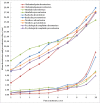Productivity loss due to menstruation-related symptoms: a nationwide cross-sectional survey among 32 748 women
- PMID: 31248919
- PMCID: PMC6597634
- DOI: 10.1136/bmjopen-2018-026186
Productivity loss due to menstruation-related symptoms: a nationwide cross-sectional survey among 32 748 women
Abstract
Objective: To evaluate age-dependent productivity loss caused by menstruation-related symptoms, measured in absenteeism (time away from work or school) and presenteeism (productivity loss while present at work or school).
Methods: Design/setting: internet-based, cross-sectional survey conducted in the Netherlands from July to October 2017.
Participants: 32 748 women aged 15-45 years, recruited through social media.
Outcome measures: self-reported lost productivity in days, divided into absenteeism and presenteeism; impact of menstrual symptoms; reasons women give when calling in sick; and women's preferences regarding the implications of menstruation-related symptoms for schools and workplaces.
Results: A total of 13.8% (n=4514) of all women reported absenteeism during their menstrual periods with 3.4% (n=1108) reporting absenteeism every or almost every menstrual cycle. The mean absenteeism related to a woman's period was 1.3 days per year. A total of 80.7% (n=26 438) of the respondents reported presenteeism and decreased productivity a mean of 23.2 days per year. An average productivity loss of 33% resulted in a mean of 8.9 days of total lost productivity per year due to presenteeism. Women under 21 years were more likely to report absenteeism due to menstruation-related symptoms (OR 3.3, 95% CI 3.1 to 3.6). When women called in sick due to their periods, only 20.1% (n=908) told their employer or school that their absence was due to menstrual complaints. Notably, 67.7% (n=22 154) of the participants wished they had greater flexibility in their tasks and working hours at work or school during their periods.
Conclusions: Menstruation-related symptoms cause a great deal of lost productivity, and presenteeism is a bigger contributor to this than absenteeism. There is an urgent need for more focus on the impact of these symptoms, especially in women aged under 21 years, for discussions of treatment options with women of all ages and, ideally, more flexibility for women who work or go to school.
Keywords: absenteeism; community gynaecology; menstrual cycle; menstruation; presenteeism.
© Author(s) (or their employer(s)) 2019. Re-use permitted under CC BY-NC. No commercial re-use. See rights and permissions. Published by BMJ.
Conflict of interest statement
Competing interests: None declared.
Figures
References
MeSH terms
LinkOut - more resources
Full Text Sources
Medical



